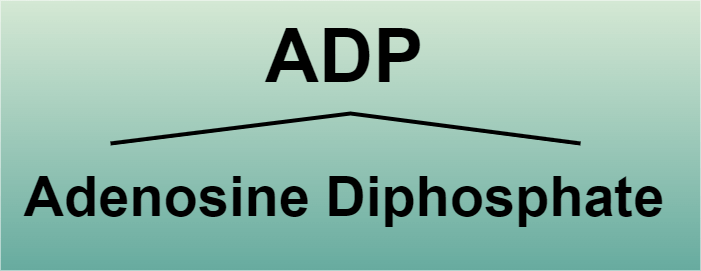What is the Full Form of ADPADP: Adenosine DiphosphateADP stands for Adenosine Diphosphate. ADP is an organic material that is formed throughout the body's metabolic process. The movement of energy within the cell to sustain the biological system is the primary function of ADP. Adenine, a phosphate molecule, and a sugar backbone make up the fundamental components of ADP. The fundamental structure of the ADP is typically made up of these components coupled to one another in a certain pattern. 
The IUPAC (International Union of Pure and Applied Chemistry) name of the Adenosine diphosphate (ADP) is Adenosine 5'- (trihydrogen diphosphates). Biochemical processes, including oxidative phosphorylation, glycolysis, catabolism, etc., all benefit from the presence of ADP. TGP can also be converted into adenosine triphosphate (ATP) as well as adenosine monophosphate (AMP) through further synthesis. Adenosine DiphosphateAdenosine Diphosphate is a chemical substance that is created owing to the metabolism that takes place within the body. It is an essential chemical that is vital for the transmission of energy in the body of a living organism. It controls a number of biological processes that take place inside a cell. Two phosphate groups attached to the 5' carbon atoms of ribose and an adenine-bonded sugar backbone make up the basic structure of ADP. Likewise, Adenine, a phosphate group along with a sugar backbone, makes up the entirety of ATP's structure. ADP can also be changed into molecules like adenosine triphosphate & adenosine monophosphate, which have different numbers of phosphate groups. TerminologyBecause of the recombination of the phosphate group, adenosine diphosphate is referred to as ADP. The energy transfer from one cell to another is the fundamental characteristic of ADP. However, phosphate group recombination occurs throughout this energy transfer step. Adenosine triphosphate (ATP) undergoes through hydrolysis process, releasing energy. Adenosine diphosphate is created when the phosphate group, commonly known as the phosphoanhydride link of adenosine triphosphate, is disrupted during hydrolysis to remove one phosphate group. In order to carry out various biological processes, the ATP is transformed into ADP, releasing a certain quantity of energy that is transmitted from one molecule to another. How ATP and ADP are related?ADP is a chemical molecule created as a result of adenosine triphosphate's (ATP) role in synthesis. In the presence of a catalyst, ATP undergoes hydrolysis, which causes the dissolution of a phosphate group. As a result, adenosine triphosphate produces adenosine diphosphate (ADP) when one of its phosphate groups is removed. A certain amount of energy is produced as a result of this reaction, and this energy is transferred from one cell to another in order to carry out various biological processes. Furthermore, by removing several phosphate groups, ATP can be further synthesized into adenosine monophosphate. Dephosphorylation is the process that breaks down the phosphate group. Adenosine diphosphate is well-known for its fundamental ability to transfer energy from one cell to another. The basic building block of ADP is two phosphate groups. Dephosphorylation of ATP is thus responsible for energy production. A number of ATPases, which are enzymes that cause the dephosphorylation of ATP, are responsible for this process. Metabolic processes occur during energy release, which results in the reformation of ADP. Features of ADPADP's fundamental role in the energy transfer from one cell to another for the synthesis of numerous biological processes is already well established. However, it results in a number of additional actions, including:
The Bottom LineAdenosine diphosphate, or ADP, is a chemical molecule that is used to transport energy from one cell to another. The progression of various biological processes in our living things is facilitated by this energy transfer. But the hydrolysis reaction between ATP and ADP, which occurs in the presence of the enzyme ATPase, is what generates this energy. Dephosphorylation is the process by which one or more phosphate groups are disassembled and eliminated from the chemical in order to provide energy. ADP is also in charge of a number of other biological processes, such as catabolism, oxidative phosphorylation, muscular contraction, creatine phosphate production, and glycolysis.
Next TopicFull Form
|
 For Videos Join Our Youtube Channel: Join Now
For Videos Join Our Youtube Channel: Join Now
Feedback
- Send your Feedback to [email protected]
Help Others, Please Share










